Test1
To avoid hard-coding values, a flow uses some property placeholders and the corresponding values are stored in a configuration file. Where does the configuration file's location need to be specified in the Mule application?
A global element
The mule-artifact.json file
A flow attribute
The pom.xml file
Refer to the exhibits.


The main flow contains an HTTP Request in the middle of the flow. The HTTP Listeners and HTTP Request use default configurations.
A web client sends a GET request to the main flow's HTTP Listener. The GET request includes query for the pedigree of a piano.
What values are accessible to the Logger component at the end of the main flow?


The main flow contains an HTTP Request in the middle of the flow. The HTTP Listeners and HTTP Request use default configurations.
A web client sends a GET request to the main flow's HTTP Listener. The GET request includes query for the pedigree of a piano.
What values are accessible to the Logger component at the end of the main flow?
Payload
Payload pedigree query params
Payload producer var
Payload pedigree query params producer var
Refer to the exhibits.

The web client sends a POST request to the ACME Order API with an XML payload. An error is returned.
What should be changed in the request so that a success response code is returned to the web client?

The web client sends a POST request to the ACME Order API with an XML payload. An error is returned.
What should be changed in the request so that a success response code is returned to the web client?
Set a request header with the name Content-Type to a value of application/octet-stream
Set a request header with the name Content-Type to a value of application/xml
Set a response header with the name Content-Type to a value of application/xml
Set a response header with the name Content-Type to a value of application/octet-stream
Refer to the exhibits.


Each route in the Scatter-Gather sets the payload to the number shown in the label.
What response is returned to a web client request to the HTTP Listener?


Each route in the Scatter-Gather sets the payload to the number shown in the label.
What response is returned to a web client request to the HTTP Listener?




Refer to the exhibits.


The input array of strings is processed by the batch job that processes, filters, and aggregates the values.
What is the last message logged by the Logger component after the batch job completes processing?


The input array of strings is processed by the batch job that processes, filters, and aggregates the values.
What is the last message logged by the Logger component after the batch job completes processing?
[ ['A', 'C', 'D'], ['E'] ]
[ 'E' ]
[ 'D', 'E' ]
[ 'A', 'C', 'D', 'E' ]
Refer to the exhibit.

The Mule application is debugged in Anypoint Studio and stops at the breakpoint.
What is the value of the payload displayed in the debugger at this breakpoint?

The Mule application is debugged in Anypoint Studio and stops at the breakpoint.
What is the value of the payload displayed in the debugger at this breakpoint?
0
Processing
Start
Complete
Refer to the exhibits.
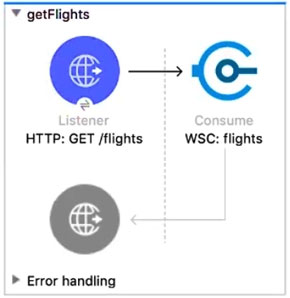

A web client sends a GET request that includes a destination query parameter to the flow's HTTP Listener. The Web Service Consumer throws a
WSC:BAD_REQUEST error.
What is the next step to fix this error?


A web client sends a GET request that includes a destination query parameter to the flow's HTTP Listener. The Web Service Consumer throws a
WSC:BAD_REQUEST error.
What is the next step to fix this error?
Set a header in the Consume operation equal to the destination query parameter
Set a SOAP payload before the Consume operation that contains the destination query parameter
Set a property in the Consume operation equal to the destination query parameter
Set a JSON payload before the Consume operation that contains the destination query parameter
Refer to the exhibit.

What DataWeave expression transforms the conductorIds array to the XML output?

What DataWeave expression transforms the conductorIds array to the XML output?

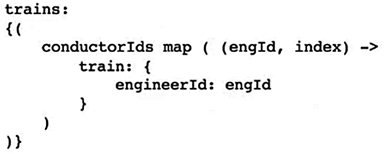


Refer to the exhibit.

The input array of strings is passed to the batch job, which does NOT do any filtering or aggregating.
What payload is logged by the Logger component?

The input array of strings is passed to the batch job, which does NOT do any filtering or aggregating.
What payload is logged by the Logger component?
Summary report of processed records
[ 'Apple', 'Banana' ]
[ 'Apple12', 'Banana12' ]
[ 'Apple1', 'Banana1', 2 ]
Refer to the exhibits.


The <when> expression for the Choice router needs to be written.
What is a valid <when> expression to route Mule events to the non-default flow?


The <when> expression for the Choice router needs to be written.
What is a valid <when> expression to route Mule events to the non-default flow?
#[ 'MuleSoft' == payload.'company' ]
#[ if ( 'MuleSoft' == payload.company ) ]
#[ company = 'MuleSoft' ]
#[ if( company = 'MuleSoft' ) ]
By default, what happens to a file after it is read using an FTP connector Read operation?
The file is moved to a different folder
The file stays in the same folder unchanged
The file is renamed in the same folder
The file is deleted from the folder
An API specification is designed using RAML. What is the next step to create a REST Connector from this API specification?
Add the specification to a Mule project's src/main/resources/api folder
Implement the API specification using flow designer in Design Center
Download the API specification and build the interface using APIkit
Publish the API specification to Anypoint Exchange
Refer to the exhibit.
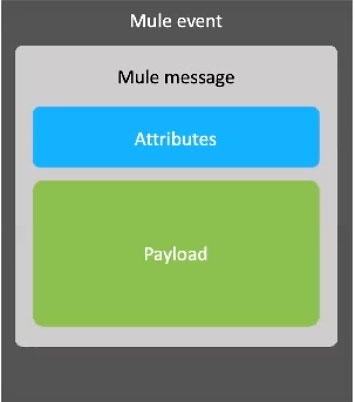
A Mule event is composed of a hierarchy of objects.
Where in the hierarchy are variables stored?

A Mule event is composed of a hierarchy of objects.
Where in the hierarchy are variables stored?
Mule message attributes
Mule message
Mule message payload
Mule event
A flow needs to combine and return data from two different data sources. It contains a Database SELECT operation followed by an HTTP Request operation. What is the method to capture both payloads so the payload from the second request does not overwrite that from the first?
Save the payload from the Database SELECT operation to a variable.
Put the Database SELECT operation inside a Cache scope.
Put the Database SELECT operation inside a Message Enricher scope.
Nothing, previous payloads are combined into the next payload.
A Mule application contains a global error handler configured to catch any errors. Where must the global error handler be specified so that the global error handler catches all errors from flows without their own error handlers?
A global element
The pom.xml file
Nowhere, the global error handler is automatically used
A configuration properties file
Refer to the exhibits.

A company has defined this Book data type and Book example to be used in APIs.
What is valid RAML for an API that uses this Book data type and Book example?

A company has defined this Book data type and Book example to be used in APIs.
What is valid RAML for an API that uses this Book data type and Book example?


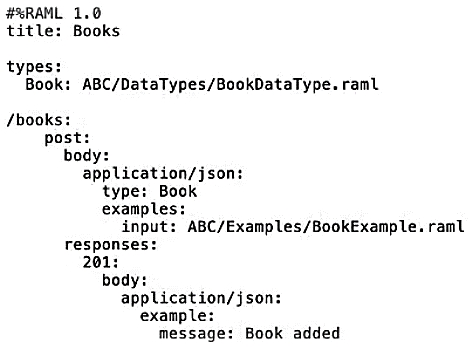

Refer to the exhibits.


A web client sends a GET request to the HTTP Listener.
What response message is returned to the web client?


A web client sends a GET request to the HTTP Listener.
What response message is returned to the web client?
''
'End'
'Start'
'String is not blank'
Refer to the exhibit.

How many private flows does APIkit generate from the RAML specification?

How many private flows does APIkit generate from the RAML specification?
1
2
3
5
Refer to the exhibits.


A web client sends a GET request to the HTTP Listener and the HTTP Request throws an error.
What payload and status code are returned to the web client.


A web client sends a GET request to the HTTP Listener and the HTTP Request throws an error.
What payload and status code are returned to the web client.
Response body: 'START' Default response status code: 200
Response body: 'ERROR1' Default response status code: 200
Response body: 'END' Default response status code: 200
Error response body: error.description Default error response status code: 500
What is the output type of the DataWeave map operator?
Object
Array
Map
String
A Mule project contains a DataWeave module called MyModule.dwl that defines a function named formatString. The module is located in the project's src/main/ resources/modules folder.
What is the correct way in DataWeave code to import MyModule using a wildcard and then call the module's formatString function?
What is the correct way in DataWeave code to import MyModule using a wildcard and then call the module's formatString fun




Refer to the exhibits.


The Validation component in the private flow throws an error.
What response message is returned to a web client request to the main flow's HTTP Listener?


The Validation component in the private flow throws an error.
What response message is returned to a web client request to the main flow's HTTP Listener?
Error - private flow
Validation Error
Error - main flow
Success - main flow
Refer to the exhibits.
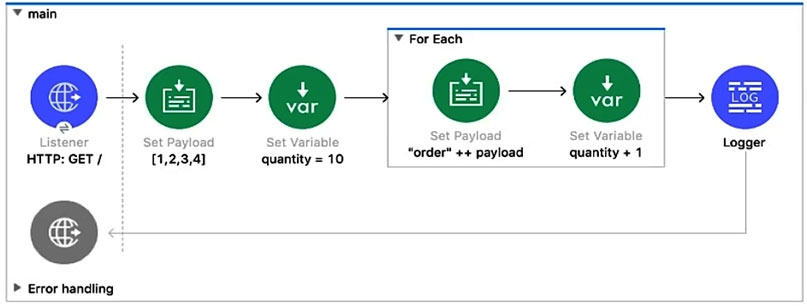

What payload and quantity are logged at the end of the main flow?


What payload and quantity are logged at the end of the main flow?
[[order1, order2, order3, order4], 14]
[[1,2,3,4], 10]
[[1,2,3,4], 14]
[order1order2order3order4, 14]
Refer to the exhibit.

What data is expected by the POST /accounts endpoint?

What data is expected by the POST /accounts endpoint?




Refer to the exhibits.
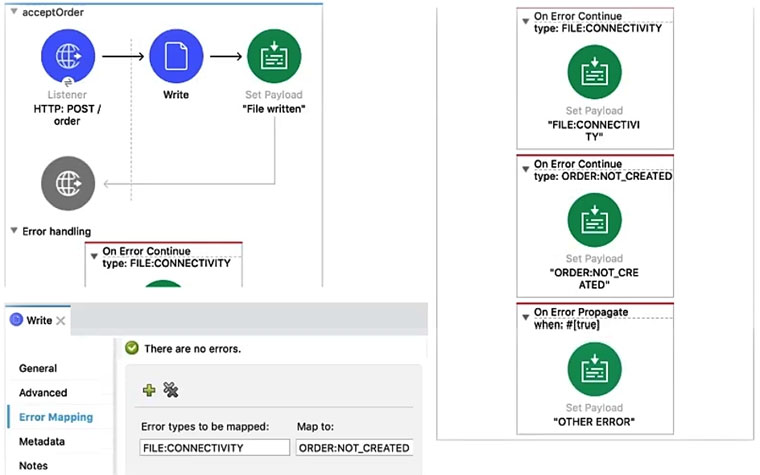
A web client sends a POST request with the payload { `oid`: `1000`. `itemid`: `AC200`, `qty`: `4` } to the Mule application. The File Write operation throws a
FILE:CONNECTIVITY error.
What response message is returned to the web client?

A web client sends a POST request with the payload { `oid`: `1000`. `itemid`: `AC200`, `qty`: `4` } to the Mule application. The File Write operation throws a
FILE:CONNECTIVITY error.
What response message is returned to the web client?
'FILE:CONNECTIVITY'
'ORDER:NOT_CREATED'
'OTHER ERROR'
'File written'
Refer to the exhibits.

The Set Payload transformer in the addItem child flow uses DataWeave to create an order object.
What is the correct DataWeave code for the Set Payload transformer in the createOrder flow to use the addItem child flow to add a router cal with the price of 100 to the order?

The Set Payload transformer in the addItem child flow uses DataWeave to create an order object.
What is the correct DataWeave code for the Set Payload transformer in the createOrder flow to use the addItem child flow to add a router cal with the price of 100 to the order?
Lookup( 'addItem', { price: '100', item: 'router', itemType: 'cable' } )
AddItem( { payload: { price: '100', item: 'router'. itemType: 'cable' } } )
Lookup( 'addItem', { payload: { price: '100', item: 'router', itemType: 'cable' } } )
AddItem( { price: '100', item: 'router'. itemType: 'cable' } )
An app team is developing a mobile banking app. It took them two months to create their own APIs to access transaction information from a central database. The app team later found out that another team had already built an API that accesses the transaction information they need. According to MuleSoft, what organization structure could have saved the app team two months of development time?
Center for Enablement
Center of Excellence
Central API Review Board
MuleSoft Support Center
Why would a Mule application use the ${http.port} property placeholder for its HTTP Listener port when it is deployed to CloudHub?
Allows CloudHub to automatically change the HTTP port to allow external clients to connect to the HTTP Listener
Allows clients to VPN directly to the application at the Mule application's configured HTTP port
Allows MuleSoft Support to troubleshoot the application by connecting directly to the HTTP Listener
Allows CloudHub to automatically register the application with API Manager
A Mule application contains an ActiveMQ JMS dependency. The Mule application was developed in Anypoint Studio and runs successfully in Anypoint Studio. The Mule application must now be exported from Anypoint Studio and shared with another developer. What export options create the smallest JAR file that can be imported into the other developer's Anypoint Studio and run successfully?




In an application network, if the implementation but not the interface of a product API changes, what needs to be done to the other APIs that consume the product API?
The applications associated with the other APIs must be restarted
The other APIs must be updated to consume the updated product API
Nothing needs to be changed in the other APIs or their associated applications
The applications associated with the other APIs must be recoded
Refer to the exhibit.

What DataWeave expression transforms the example XML input to the CSV output?

What DataWeave expression transforms the example XML input to the CSV output?




Refer to the exhibits.


The Mule application contains a Choice router.
What is logged when the flow completes?


The Mule application contains a Choice router.
What is logged when the flow completes?
US
'REGION'
EU
['US', 'EU']
A web client submits a request to http://localhost:8081/books/0471767840. The value `0471767840` is captured by a Set Variable transformer to a variable named bookISBN. What is the DataWeave expression to access bookISBN later in the flow?
Attributes.bookISBN
FlowVars.bookISBN
Vars.bookISBN
BookISBN
Refer to the exhibits.

The main flow contains a Flow Reference to the child flow.
A web client sends a GET request to the main flow's HTTP Listener that includes a make query parameter.
What values are accessible in the child flow?

The main flow contains a Flow Reference to the child flow.
A web client sends a GET request to the main flow's HTTP Listener that includes a make query parameter.
What values are accessible in the child flow?
Payload
Payload make query param
Payload model var
Payload make query param model var
Refer to the exhibit.

The Database Select operation returns five rows from a database.
What is logged by the Logger component?

The Database Select operation returns five rows from a database.
What is logged by the Logger component?
'Array'
'Object'
'LinkedHashMap'
'CaseInsensitiveHashMap'
A company has an API to manage departments, with each department identified by a unique deptId. The API was built with RAML according to MuleSoft best practices. What is valid RAML to specify a method to update the details for a specific department?




Refer to the exhibit. APIkit is used to generate flow components for the RAML specification.

How many APIkit Router components are generated to handle requests to every endpoint defined in the RAML specification?

How many APIkit Router components are generated to handle requests to every endpoint defined in the RAML specification?
1
2
3
5
Refer to the exhibits. The Mule application does NOT define any global error handlers.


The Validation component in the Try scope throws an error.
What response message is returned to a client request to the main flows HTTP Listener?


The Validation component in the Try scope throws an error.
What response message is returned to a client request to the main flows HTTP Listener?
“Error –main flow”
�Error –Try scope”
�Success –main flow”
Validation Error
Refer to the exhibit. The Default scope in the Choice router recursively calls the color flow.

A web client sends a PUT request to the HTTP Listener with payload “Blue”.
What response is returned to the web client?

A web client sends a PUT request to the HTTP Listener with payload “Blue”.
What response is returned to the web client?
�Green”
A timeout error
�Bik”
[“Blue”, “Red”, “Bik”]
An organization is beginning to follow MuleSoft’s recommended API-led connectivity approach to use modern APIs to support the development and lifecycles of their integration solutions and to close the IT delivery gap. What distinguishes between how modern APIs are organized in a MuleSoft-recommended API-led connectivity approach vs. Other common enterprise integration solutions?
The API interfaces are specified as macroservices, with one API representing all the business logic of an existing and proven end-to-end integration solution.
The API implementations are monitored with common tools, centralized monitoring, and security systems.
The API interfaces are specified at a granularity intended for developers to consume specific aspects of integration processes.
The API implementations are built with standards using common lifecycle and centralized configuration management tools.
Refer to the exhibits. A Mule application polls a database table.

This error is logged when the Mule application is run.
What should be changed in the Database connector configuration to resolve this error?

This error is logged when the Mule application is run.
What should be changed in the Database connector configuration to resolve this error?
Configure the correct JDBC driver
Configure the correct table name
Configure the correct host URL
Configure the correct database name
Refer to the exhibit. How should the WHERE clause be changed to set the city and state values from the configured input parameters?


WHERE city = :city AND state = :state
WHERE city = attributes.city AND state = attributes.state
WHERE city := ${city} AND state := ${state}
WHERE city = #[city] AND state = #[state]
Refer to the exhibits. The Set Payload transformer sets the payload to an object. The Logger component’s message attribute is configured with the string ‘Result #[INFO" ++ payload]’.

What is logged when the flow executes?

What is logged when the flow executes?
ERROR ... “You called the function ‘++’ with these arguments:
1: String ("INFO")
2: Object ({one: (child1: “Name1” as String {class: “java.lang.String”},child2: “Name2” ...)
...
1: String ("INFO")
2: Object ({one: (child1: “Name1” as String {class: “java.lang.String”},child2: “Name2” ...)
...
ERROR: You evaluated an inline expression ‘#’ without ++
Result: INFO { \”one\”: { \”child1\”: \”Name1\”, \”child2\”: \”Name2\” }
Result: INFOpayload
Following MuleSoft’s recommended API-led connectivity approach, an organization has created an application network. The organization now needs to create an API to transform, orchestrate, and aggregate data proved by other APIs in the application network. This API should be flexible enough to handle data from additional APIs in the future. According to MuleSoft’s recommended API-led connectivity approach, what is the best layer for this new API?
Experience layer
Security layer
System layer
Process layer
Refer to the exhibits. The main flow contains an HTTP Request operation configured to call the child flow’s HTTP Listener.


A web client sends a GET request the HTTP Listener with the qty query parameter set to 30.
After the HTTP Request operation completes, what parts of the Mule event at the main flow’s Logger component are the same as the Mule event that was input to the HTTP Request operation?


A web client sends a GET request the HTTP Listener with the qty query parameter set to 30.
After the HTTP Request operation completes, what parts of the Mule event at the main flow’s Logger component are the same as the Mule event that was input to the HTTP Request operation?
The entire Mule event
The payload and all variables
All variables
The payload and all attributes
A Mule application’s HTTP Listener is configured with the HTTP protocol. The HTTP Listener's port attribute is configured with a property placeholder named http.port. The Mule application sets the http.port property placeholder’s value to 9090.
Tho Mule application’s deployed to CloudHub without setting any properties in the Runtime Manager Properties tab, and a log message reports the status of the HTTP Listener after the Mule application deployment completes.
After the Mule application is deployed, what information is reported in the worker logs related to the port on which the Mule application’s HTTP Listener listens?
Tho Mule application’s deployed to CloudHub without setting any properties in the Runtime Manager Properties tab, and a log message reports the status of the HTTP Listener after the Mule application deployment completes.
After the Mule application is deployed, what information is reported in the worker logs related to the port on which the Mule application’s HTTP Listener listens?
The HTTP Listener is listening on port 8081.
The HTTP Listener is listening on port 9090.
The HTTP Listener failed to bind to the port and is not listening for connections.
The HTTP Listener is listening on port 80.
A REST Connect module is generated for a RAML specification, and then the REST Connect module is imported into a Mule application.
For each method of the RAML specification, what does the REST Connect module provide?
For each method of the RAML specification, what does the REST Connect module provide?
A flow
A scope
An event source
An operation
Refer to the exhibits. The Batch Job scope contains two Batch Step scopes with different accept expressions.
Input payload:

The input payload is passed to the Batch Job scope.
After the entire payload is processed by the Batch Job Scope, what messages have been logged by the Logger components?
Input payload:

The input payload is passed to the Batch Job scope.
After the entire payload is processed by the Batch Job Scope, what messages have been logged by the Logger components?
{ “amount”: 500 }
{ “amount”: 101 }
{ “step2amount”: 1000 }
{ “step2amount”: 500 }
{ “amount”: 101 }
{ “step2amount”: 1000 }
{ “step2amount”: 500 }
{ “amount”: 500 }
{ “amount”: 101 }
{ “step2amount”: 1000 }
{ “step2amount”: 400 }
{ “amount”: 101 }
{ “step2amount”: 1000 }
{ “step2amount”: 400 }
{ “amount”: 500 }
{ “amount”: 601 }
{ “step2amount”: 1000 }
{ “step2amount”: 500 }
{ “step2amount”: 601 }
{ “amount”: 601 }
{ “step2amount”: 1000 }
{ “step2amount”: 500 }
{ “step2amount”: 601 }
{ “amount”: 500 }
{ “amount”: 101 }
{ “step2amount”: 1000 }
{ “amount”: 101 }
{ “step2amount”: 1000 }
Refer to the exhibits. The Batch Job scope processes the array of strings.

After the Batch Job scope completes processing the input payload, what information is logged by the Logger component?

After the Batch Job scope completes processing the input payload, what information is logged by the Logger component?
[“A”, “B”, “C”]
Total Records processed: 3 -
Successful records: 3 -
Failed Records: 0 -
payload (“A”, “B”, “C”)
Successful records: 3 -
Failed Records: 0 -
payload (“A”, “B”, “C”)
Total Records processed: 1 -
Successful records: 1 -
Failed Records: 0 -
payload [“A”, “B”, “C”]
Successful records: 1 -
Failed Records: 0 -
payload [“A”, “B”, “C”]
Total Records processed: 3 -
‘Successtul records: 3
Failed Records: 0
‘Successtul records: 3
Failed Records: 0
An API instance of type API endpoint with API proxy is created in API Manager using an API specification from Anypoint Exchange. The API instance is also configured with an API proxy that is deployed and running in CloudHub.
An SLA-based policy is enabled in API Manager for this API instance.
Where can an external API consumer obtain a valid client ID and client secret to successfully send request to the API proxy?
An SLA-based policy is enabled in API Manager for this API instance.
Where can an external API consumer obtain a valid client ID and client secret to successfully send request to the API proxy?
In Anypoint Studio, from components generated by APIkit for the API specification
In Anypoint Studio, from components generated by REST Connect for the API specification
In Runtime Manager, from the Properties tab of the deployed approved API proxy
In the organization’s pubic API portal in Anypoint Exchange, from an approved client application for the API proxy
Refer to the exhibit. The Mule application’s connectors are configured with property placeholders whose values are set in the config.yaml file.
What must be added to the Mule application to link the config.yaml file’s values with the property placeholders?

What must be added to the Mule application to link the config.yaml file’s values with the property placeholders?

A dependency element in the pom.xml file
A file-config element in the acme-app.xml file
A propertiesFile key/value pair in the mule.artifact.json file
A configuration-properties element in the acme-app.xml file
A Mule project contains a DataWeave module file WebStore.dwl that defines a function named loginUser. The module file is located in the project’s src/main/resources/libs/dw folder.
What is correct DataWeave code to import all of the WebStore.dwl file’s functions and then call the loginUser function for the login “cindy.park@example.com”?
What is correct DataWeave code to import all of the WebStore.dwl file’s fun
import libs.dw.WebStore
---
loginUser( “cindy.park@example.com” )
---
loginUser( “cindy.park@example.com” )
import * from libs::dw
---
WebStore::loginUser( “cindy.park@example.com” )
---
WebStore::loginUser( “cindy.park@example.com” )
import * from libs::dw::WebStore
---
loginUser( “cindy.park@example.com” )
---
loginUser( “cindy.park@example.com” )
import libs.dw
---
WebStore.loginUser( “cindy.park@example.com” )
---
WebStore.loginUser( “cindy.park@example.com” )
What is the output type of the DataWeave flatten function?
Object
Array
Map
Java
Refer to the exhibits. The main flow contains a Flow Reference component configured to call the child flow.


What can be accessed from the child flow?
The payload and all attributes
The payload and all variables
The entire Mule event
The payload
A Mule application configured with autodiscovery implements an API.
Where is governance enforced for policies defined for this Mule application?
Where is governance enforced for policies defined for this Mule application?
In a separate API proxy application
In Runtime Manager
In API Manager
In the Mule application
An organization's Center for Enablement (CAE) has built foundational assets (API specifications and implementation template, common frameworks, and best practices guides) and published them to Anypoint Exchange.
What is a metric related to these foundational assets that helps the organization measure the success of its C4E efforts?
What is a metric related to these foundational assets that helps the organization measure the success of its C4E efforts?
Correlation of key performance indicators (KPIs) of production applications with foundational assets
Correlation of each foundational asset with the counts of developers that downloaded each asset
Utilization counts of foundational assets in production applications
Counts of how many lines of businesses (LoBs) consumed each foundational asset
Refer to the exhibits. The Set Variable transformer is set with value #[{ first: “Max”, last “Mule” }].

What is a valid DateWeave expression to set as the message attribute of the Logger to access the value “Max” from the Mule event?

What is a valid DateWeave expression to set as the message attribute of the Logger to access the value “Max” from the Mule event?
Vars.”customer”. “first”
Customer.first
�customer.first”
Vars.”customer.first”
Refer to the exhibits. The Mule application configures and uses two HTTP Listener global configuration elements.

The Mule application is run in Anypoint Studio.
If the Mule application starts correctly, what URI and port number(s) can receive web client requests; if the Mule application fails to start, what is the cause of the failure?

The Mule application is run in Anypoint Studio.
If the Mule application starts correctly, what URI and port number(s) can receive web client requests; if the Mule application fails to start, what is the cause of the failure?
The Mule application starts successfully
Web client requests can only be received at the URI on port 2222, not on port 3333
Web client requests can only be received at the URI on port 2222, not on port 3333
The Mule application fails to start
There is a port bind conflict because the HTTP Request also uses port 3333
There is a port bind conflict because the HTTP Request also uses port 3333
The Mule application starts successfully
Web client requests can be received at the URI /on port 2222 or port 3333
Web client requests can be received at the URI /on port 2222 or port 3333
The Mule application fails to start
There is a URL path conflict because both HTTP Listeners are configured with the same path /
There is a URL path conflict because both HTTP Listeners are configured with the same path /
A shopping API contains a method to look up store details by department.
To get information for a particular store, web clients will submit requests with a query parameter named department and a URI parameter named storeId.
What is a valid RAML snippet that supports requests from web clients to get data for a specific storeId and department name?
To get information for a particular store, web clients will submit requests with a query parameter named department and a URI parameter named storeId.
What is a valid RAML snippet that supports requests from web clients to get data for a specific storeId and department name?
/department:
get:
uriParameter:
storeId:
get:
uriParameter:
storeId:
/department:
get:
uriParameter:
{storeid}:
queryParameters:
department:
get:
uriParameter:
{storeid}:
queryParameters:
department:
/department:
/{storeid}:
get:
queryParameters:
department:
get:
queryParameters:
department:
/department:
get:
queryParameters:
department:
uriParameter:
storeId:
queryParameters:
department:
uriParameter:
storeId:
Refer to the exhibit. A Mule application configures a property placeholder file named config.yaml to set some property placeholders for an HTTP connector.

What is a valid properties placeholder file to set these values?

What is a valid properties placeholder file to set these values?
{
http:
basePath: “api”
port: “8081”
host: “localhost”
}
http:
basePath: “api”
port: “8081”
host: “localhost”
}
http.port = 8081
http.host = “localhost”
http.host = “localhost”
http:
basePath: “api”
port: “8081”
host: “localhost”
basePath: “api”
port: “8081”
host: “localhost”
http:
port = “8081”
host = “localhost”
port = “8081”
host = “localhost”
{"name":"Test1", "url":"https://www.quiz-maker.com/QPREVIEW","txt":"To avoid hard-coding values, a flow uses some property placeholders and the corresponding values are stored in a configuration file. Where does the configuration file's location need to be specified in the Mule application?, Refer to the exhibits.The main flow contains an HTTP Request in the middle of the flow. The HTTP Listeners and HTTP Request use default configurations.A web client sends a GET request to the main flow's HTTP Listener. The GET request includes query for the pedigree of a piano.What values are accessible to the Logger component at the end of the main flow?, Refer to the exhibits.The web client sends a POST request to the ACME Order API with an XML payload. An error is returned.What should be changed in the request so that a success response code is returned to the web client?","img":"https://www.quiz-maker.com/3012/images/ogquiz.png"}
More Quizzes
ACTIVE AND PASSIVE VOICE
52137
GNRQuizz7
105636
Women in science: find the lie
10525
Which Hogworts House are you in?
420
Movie Soundtrack Trivia - Test Your Film Music Knowledge
201020683
Guess the Car by the Picture - One-Part (Free)
201018517
Metamorphism - How Rocks Change Form
201015937
First Letter of Your Soulmate's Name - Free
201019001
Free Side Hustle - Find Your Best Fit in Minutes
201016641
MeTV - 70s TV Classics Trivia Challenge
201020275
Who Is My Role Model? - Free, Instant Results
201017060
Ballet Vocabulary - Test Your Knowledge
201016527